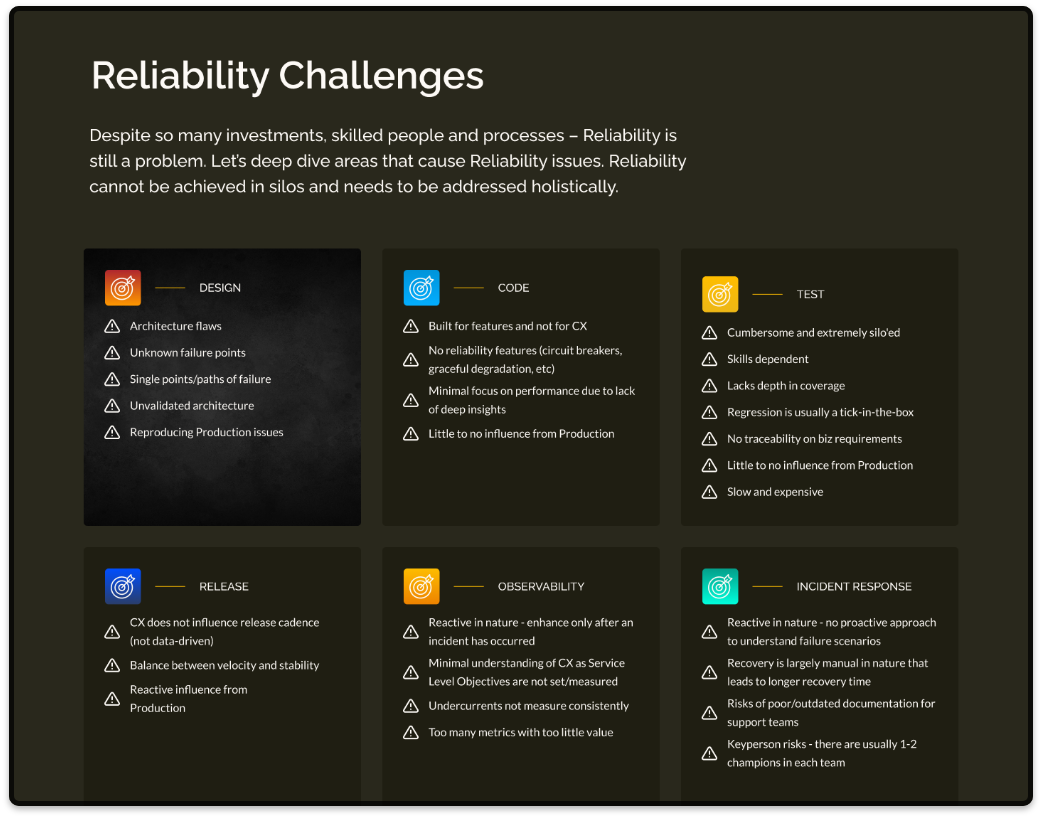About
The Watermelon team comprises of practitioners and technologists who bring their true experiences and learnings from real-world enterprises and start-ups into the platform. The Watermelon philosophy wasn’t simply to build features but rather focus on use-cases and then deliver the features to support those use-cases. We strive to continually learn and innovate to deliver the best of class capabilities to make organizations successful by strengthen their Reliability posture.
The Ask
Designs in Automation Testing, Chaos Engineering & Error Budgets
Introduction:
Automation testing, chaos engineering, and error budgets are crucial components in modern software development and operations. This case study explores the design aspects of these practices and their impact on the reliability and efficiency of software systems.
1. Automation Testing:
Automation testing is the process of using software tools and scripts to execute test cases in an automated manner. It helps to ensure the quality and functionality of software applications. Effective design in automation testing involves the following key considerations:
a) Test Framework Design:
A well-designed test framework provides a structured approach to test automation. It focuses on modularity, reusability, and maintainability of test cases. The framework should be scalable and support different types of testing, such as functional, regression, and performance testing.
b) Test Data Management:
Efficient management of test data is essential for automation testing. Design considerations include data-driven testing, where test cases are executed with multiple datasets, and the design of data repositories to store and retrieve test data.
c) Test Case Design:
Test cases must be designed to cover all possible scenarios and edge cases. They should be concise, clear, and easy to maintain. The use of test design techniques, such as boundary value analysis and equivalence partitioning, can help in creating effective test cases.
2. Chaos Engineering:
Chaos engineering is a discipline that focuses on creating controlled experiments to uncover weaknesses and vulnerabilities in a system. Designing chaos engineering experiments involves the following aspects:
a) Hypothesis Design:
Before conducting chaos experiments, a clear hypothesis should be defined. This hypothesis guides the design of experiments and helps in identifying the areas of the system that need to be tested under chaotic conditions.
b) Controlled Chaos:
Chaos experiments must be designed to simulate real-world scenarios that can potentially disrupt the system. However, it is important to ensure that the experiments are controlled and do not cause irreversible damage. Designing chaos engineering experiments involves defining the scope, duration, and intensity of chaos to be introduced.
c) Monitoring and Observability:
Effective monitoring and observability are crucial for chaos engineering. Designing a robust monitoring system helps in understanding the impact of chaos experiments on the system and enables the detection of anomalies and failures.
3. Error Budgets:
Error budgets are a concept used in reliability engineering to set limits on acceptable failure rates in a system. They help in balancing the need for innovation and reliability. Design considerations for error budgets include:
a) Defining Acceptable Error Rates:
Error budgets require defining acceptable levels of errors or failures based on the impact they have on the user experience or business operations. This involves setting thresholds for different types of errors and failures.
b) Monitoring and Alerting:
A well-designed monitoring and alerting system is essential for tracking error budgets. It helps in proactively identifying when error rates approach or exceed the defined thresholds. Designing effective monitoring and alerting systems involves selecting appropriate metrics and defining alerting mechanisms.
c) Iterative Improvement:
Designing error budgets involves an iterative process of setting thresholds, monitoring, and making improvements based on the data and feedback received. The design should allow for continuous improvement in the system's reliability and the adjustment of error budgets as needed.
Conclusion:
Design plays a crucial role in automation testing, chaos engineering, and error budgets. Well-designed frameworks, test cases, experiments, and monitoring systems contribute to the reliability and efficiency of software systems. By considering the design aspects discussed in this case study, organizations can enhance their testing practices, uncover vulnerabilities, and balance reliability with innovation.


